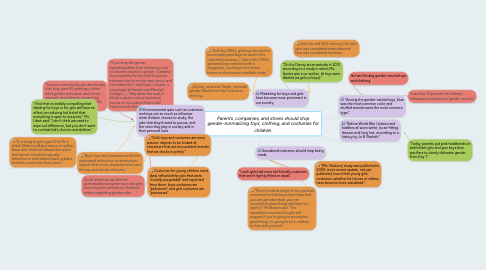Parents, companies, and stores should stop gender-normalizing toys, clothing, and costumes for children.
by Paycence Stonebraker

1. "I wish girls had more kid-friendly costumes that aren't tightly fitted or sexist."
2. "Toys are more strictly gendered today than they were 50 years ago, when adult gender roles were much more separate, according to research by Elizabeth Sweet, a sociologist at the university of California, Davis."
3. Marketing for boys and girls have become more prominent in our society.
4. "Until the 1960s, girls toys focused on homemaking and boys on work in the industrial economy [...] But in the 1990s, gendered toys returned with a vengeance, resulting in the action heroes and princesses available today."
5. "Boys' toys and costumes tend of be associated with action or destruction: objects that move, characters that save the say and animals that prey."
6. "In a study of girls ages 10 to 15 in which [Rebecca Bigler] was a co-author, those who had internalized the notion that women should be sexually attractive to men earned lower graders and test scores than their peers."
7. "If you drop the gender marketing,rather than narrowing a set of interests based on gender, it widens the possibility for the child to pursue interests that he or she cares about and has a talent for," said Carol J. Auster, a sociologist at Franklin and Marshall College [...]. "Way down the road, it allows a grown men or woman to pursue an occupation that is well matched with their talents or skills."
8. Sexualized costumes should stop being made.
9. Disney, as well as Target, removed gender labels from their costumes and toys.
10. Social scientists say that the generalization between boys and girls have long-term affects on childrens notions regarding gender roles
11. "I find that incredibly compelling that labeling for boys or for girls will have an effect on reducing kid' belief that everything is open to everyone," Ms. Liben said. "I don't think we need to wipe out difference, but you don't want to contrast kid's choices and abilities."
12. Costumes for young children most likely reflected the jobs that were "socially acceptable" and expected from them: boys costumes are "policemen" and girls costumes are "princesses".
13. Environmental ques such as costumes and toys can so much as influence what children choose to study, the jobs that they'd want to pursue, and the roles they play in society and in their personal lives.
14. "Girls' toys and costumes are more passive: objects to be looked at, characters that are rescued and animals that are docile or pretty."
15. "There's a whole range of very positive costumes for little boys that stress that you can get adventure, you can accomplish great things and have the right to," Ms.Nelson said. "The equivalent costumes for girls still suggest if you're going to accomplish great things, its going to be in relation to how well you look."
16. "Less than 10 percent of childrens Halloween costumes are gender-neutral."
17. "Before World War I, babies and toddlers all wore white, loose-fitting dresses and long hair, according to a history by Jo B. Paoletti."
18. "Today, parents put pink headbands on bald infant girls and give boys blue pacifiers to clearly delineate gender from Day 1."
19. "On the Disney store website in 2012, according to a study in which Ms. Auster was a co-author, all toys were labeled [as girls or boys]."
20. "Among the gender-neutral toys, blue was the most common color, and stuffed animals were the most common type."
21. Its hard finding gender-neutral toys and clothing.
22. Until the mid-20th century, the color pink was considered masculine and blue was considered feminine.
23. "[Ms. Nelsons] study was published in 2000, and a recent update, not yet published, found that young girls' costumes, whether for heroes or villains, have become more sexualized."


